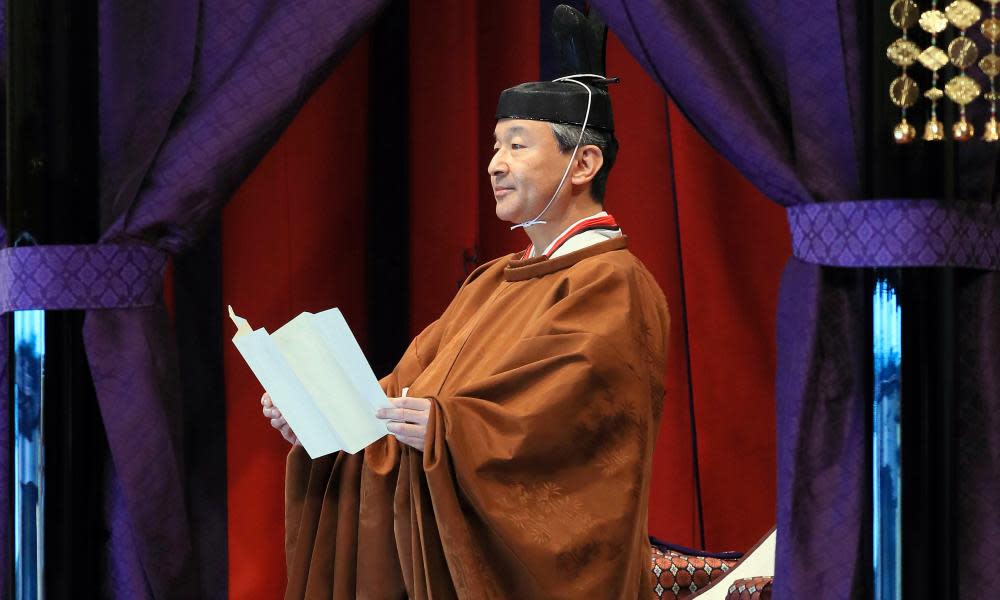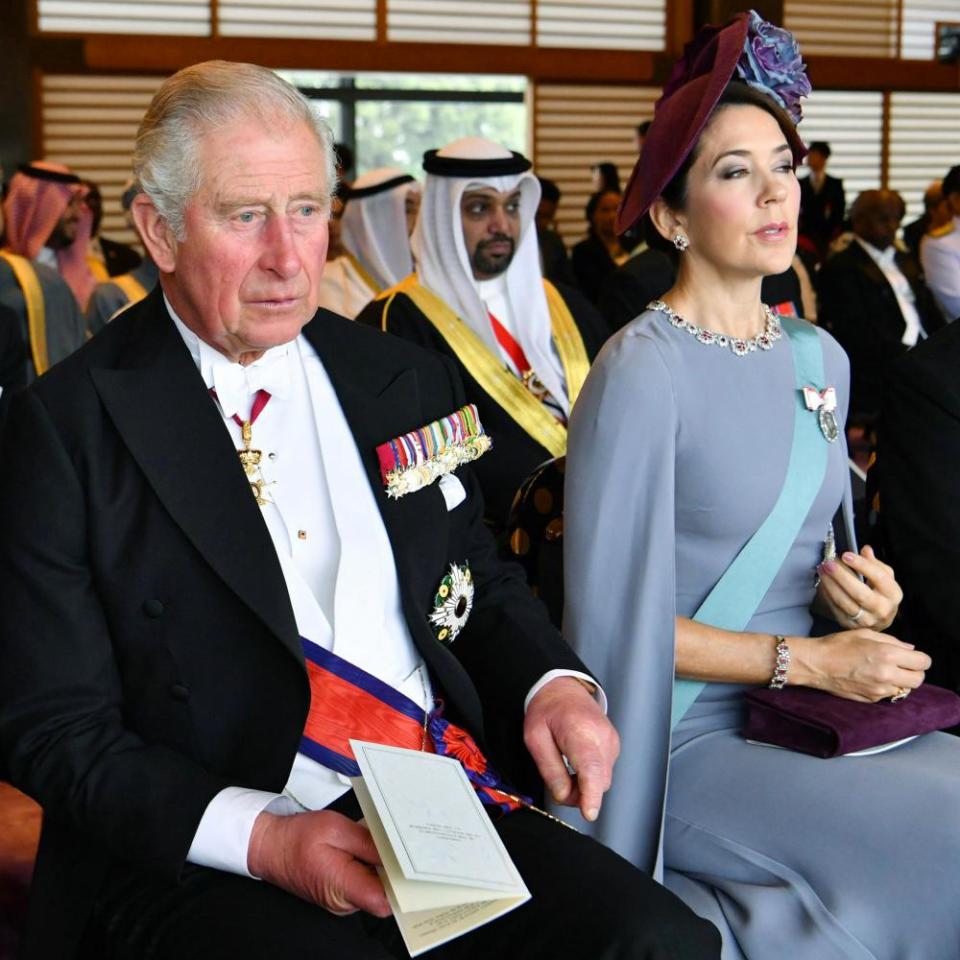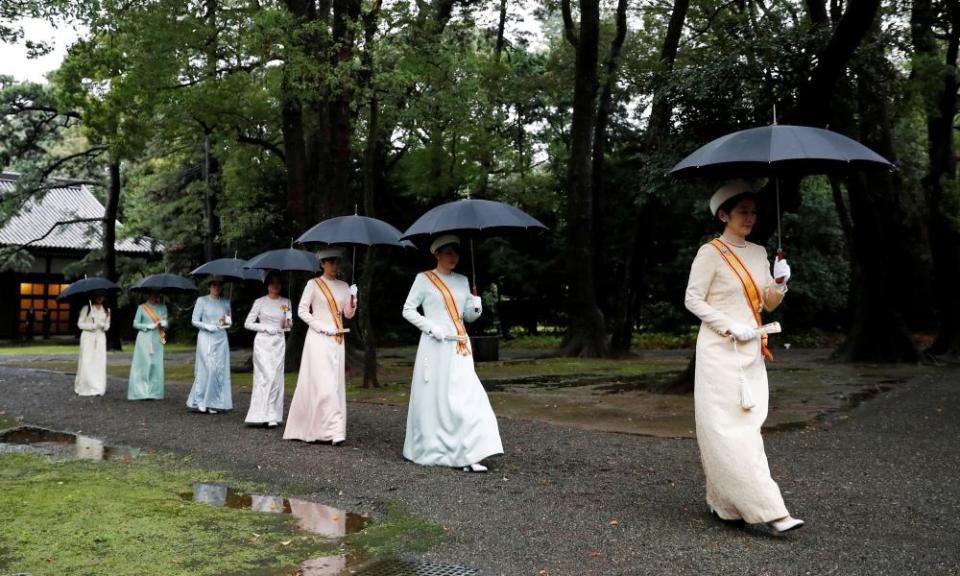Japan grants half a million pardons to mark enthronement of emperor Naruhito

Japan has pardoned more than half a million people found guilty of petty crimes such as traffic violations to mark the formal ascension of Naruhito to the Chrysanthemum throne.
Naruhito proclaimed himself Japan’s new emperor and vowed to “stand with the people” after performing a series of ancient rituals on Tuesday that culminated in his appearance on the imperial throne alongside his wife, Empress Masako.
The 59-year-old, who ascended the throne in May following the abdication of his father, Akihito, marked his official enthronement in front of around 2,000 guests, including heads of state and other royals from more than 180 countries.
“I hereby declare my enthronement at home and abroad,” said Naruhito. Dressed in a dark orange robe whose design dates back 1,000 years, Japan’s 126th emperor paid tribute to 85-year-old Akihito’s dedication to public service and said he would continue his father’s work.
Naruhito vowed to act according to the postwar constitution, which regards the reigning emperor as a “symbol of the sate and of the unity of the people, while always wishing for the happiness of the people and the peace of the world, turning my thoughts to the people and standing by them”.
He added: “I sincerely hope that our country, through our people’s wisdom and unceasing efforts, achieves further development and contributes to the friendship and peace of the international community and the welfare and prosperity of humankind.”
Facing Naruhito from a position below the imperial throne, the prime minister, Shinzo Abe, offered his congratulations. “We will do our utmost to create a peaceful, bright future full of hope for Japan,” Abe said, before leading the guests in three cheers of “Banzai” (Long live the emperor).
The series of rites, steeped in Japan’s indigenous Shinto religion, began on a morning of heavy rain.
The 59-year-old head of the world’s oldest hereditary monarchy donned a white robe at a sacred spot inside the imperial palace grounds known as Kashikodokoro, and announced his enthronement to Amaterasu, the mythical sun goddess from whom all Japan’s monarchs are said to be descended.
Accompanied by palace staff in black robes carrying decorative boxes containing the imperial treasures of a sword and jewel, Naruhito walked slowly to the first shrine, bowed deeply and went inside to pray. He made similar visits to two other shrines.
Later, he took his place on the 6.5-metre-high (21-foot) Takamikura throne alongside Masako, a Harvard-educated non-royal whom he married in 1993, in a 30-minute ceremony at Matsu-no-Ma (Hall of Pine), the imperial palace’s most prestigious space.
Among the dignitaries attending the ceremony were Prince Charles, the US transportation secretary Elaine Chao, China’s vice president, Wang Qishan, the South Korean prime minister, Lee Nak-yon, and Myanmar’s Aung San Suu Kyi.

The enthronement had drawn criticism from those who questioned the use of 16 billion yen ($150m) in taxpayers’ money to pay for rituals they believe violate the constitutional separation between state and religion.
Others had voiced concern that Abe’s congratulatory message, delivered from a point physically below that of the emperor and empress, contradicted the postwar constitution’s assertion that sovereignty lies with the Japanese people.
After the second world war, the US-led occupation authorities stripped Naruhito’s grandfather, Hirohito, of his divine status, making him a purely symbolic figure with no formal political power.
To mark the occasion on Tuesday, Abe’s ultra-conservative government granted pardons to about 550,000 eligible applicants. The decision was not publicly debated.
The pre-war custom of clemency by the emperor, who was revered as a god in those days, has triggered criticism as being undemocratic and politically motivated. At the time of former Akihito’s enthronement, 2.5 million people were given amnesty.

Later on Tuesday the royal couple were scheduled to host a court banquet attended by about 400 foreign dignitaries along with Japanese government ministers, MPs and senior judges.
The original itinerary included a parade in which Naruhito and Masako were to be driven around the streets of Tokyo in an open-top car, giving tens of thousands of people the opportunity to welcome them on a day that has been declared a national holiday.
Last week, however, the government announced that the parade would be postponed until November as a show of respect for victims of Typhoon Hagibis, which killed 80 people and caused widespread flooding and destruction.
Naruhito’s enthronement has raised hopes that his reign, known as Reiwa (beautiful harmony), will usher in a period of gentle modernisation for the imperial family. The monarch, who spent two years at Oxford University and wrote his master’s thesis on ancient maritime transport on the River Thames, has indicated that he will continue Akihito’s work in bringing the imperial family closer to ordinary people.
It has also focused attention on a looming succession crisis. Japan’s imperial household law forbids females from ascending the throne, and Abe’s conservative government has shown little interest in revising it to increase the pool of potential successors.
Currently only two members of the imperial family are eligible to become emperor – Naruhito’s younger brother, Crown Prince Akishino, and his 13-year-old son, Prince Hisahito. Naruhito and Masako have one child, 17-year-old Princess Aiko.

 Yahoo News
Yahoo News 
